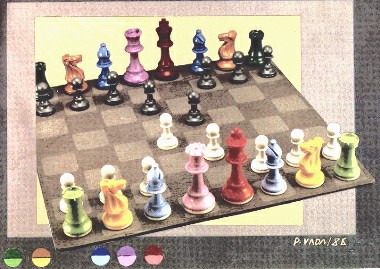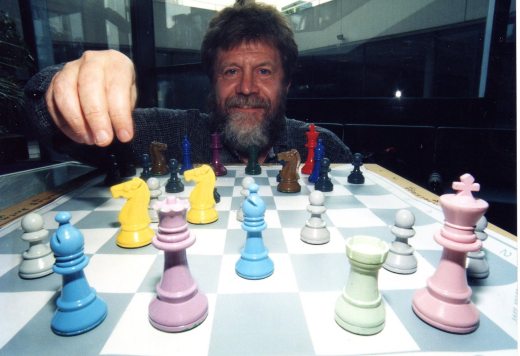

The Rainbow Chess is the first ever chess software using color coded chess set and notation (as an option besides the traditional white/black chess set) to enhance the visual perception in learning and training chess without changing any rules of the traditional chess.
The software uses the popular and standard PGN (Portable
Game Notation) databases (max. 15000 games in the demo version).
To find them on the internet, enter pgn games words into
Google search:
http://www.google.com/search?hl=en&q=pgn+games&btnG=Google+Search&aq=-1&oq=
It has interactive and ready-to-print RTF (Rich Text Format) movelist page with optional diagram graphics and unique statistical graph features.
FIDE ELO rating databases can also be loaded in the program for browsing
and searching. They can be dowloaded from here:
http://ratings.fide.com/download.phtml

Download Rainbow Chess demo, try and enjoy it!
The officers behind the ranks of 'traditional' Black and White pawns have their own colours. KINGS ARE RED, QUEENS ARE PURPLE, BISHOPS ARE BLUE,KNIGHTS ARE YELLOW, and ROOKS ARE GREEN.

The original design of Mr. Suvada, the inventor
And, as the 'Black' pieces are the DARKER SHADES of the 'White' ones,
there can be no problem with telling them apart! You can easily get accustomed
to the 'orgy' of colours, which is really strange at first sight.
According to inventor Pál Suvada (1912-1995),
his idea, which was patented in the USA more than 30 years ago, can have
numerous advantages (his hypotheses are based on the result of earlier
research):
Suvada Pál (painter artist) has returned to Hungary - our native land - in 1991 after decades he spent in the US. Although he was not a strong player never lost his interest for 'Colour Chess' as he called all the mutations he made. However I re-baptized to 'Rainbow Chess' those models which kept the original form of the pieces and were just coloured. Mr Suvada made a foundation in order to test his invention in different forms. Not much happened for years. That was the time (1994) when I took over the foundation and immediately organized the first ever Rainbow Rapid in the Papp Béla Memorial. Then there came quite a lot more in different arts, in 1997 we had the World premier already FIDE rated. Needless to say, you cannot declare a conclusion after even much more tournaments. But it was encouraging to see tournaments usually played by partners of whom none had played this kind of chess before on a similar level as the traditional. And not worse!
